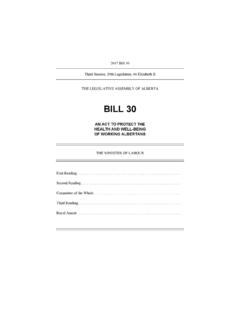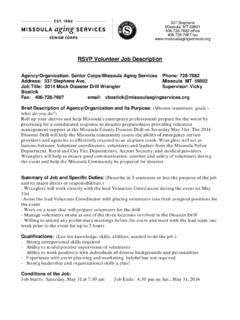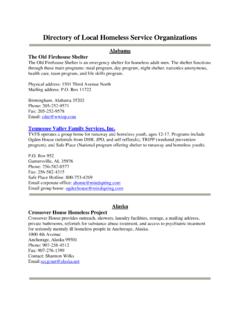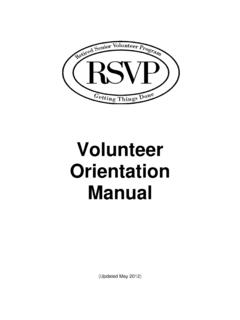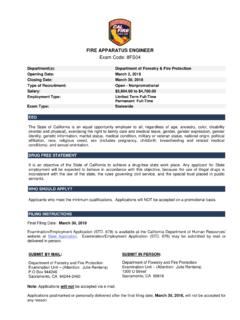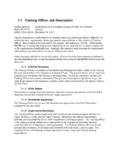Transcription of A Code of Practice for Fire Fighters
1 - 1 - The Occupational Health and Safety Code made by the Occupational Health and Safety Council on September 23, 2003 was adopted and came into force on April 30, 2004. A Code of Practice for Fire Fighters Application of the Alberta Occupational Health and Safety Code to Emergency Operations of the Fire Service in Alberta - 2 - Purpose: This Code of Practice provides explanations of Alberta s Occupational Health and Safety Act (the Act) (O-2 RSA 2000), Occupational Health and Safety Regulation (the Regulation: 62/2003) and the Occupational Health and Safety Code (the OHS Code) as those laws pertain to the emergency operations of a fire department in Alberta.
2 This Code of Practice is intended to deal primarily with the special work sites commonly known by the emergency services industry as an emergency incident and to situations where workers involved in delivering emergency services are responding at these sites. This Code of Practice is designed to set out the minimum standards to which a fire service must comply with the above mentioned health and safety legislation and looks specifically at those sections of the legislation where clarification and explanation in their application to the fire service and emergency operations has been requested.
3 Where there is no explanation provided, the reader is referred back to the applicable section(s) of the OHS Act, Code, or Regulation. The main goals of the legislation are to prevent accidents, injuries and exposures, and to reduce the severity of the accidents, injuries and exposures that do occur among Alberta s workers, including firefighters. Any reference to worker in the legislation or in this Code of Practice is meant to be interpreted in its broadest sense and includes all persons working for an employer and includes firefighters, officers, chief officers, supervisors, managers, directors etc.
4 , regardless of their employment status. Firefighters employed as volunteer, part time, full time or any combination of these are also considered to be workers by the OHS Act. Copies of the OHS Act, Regulation or Code are available at websites listed below: Workplace Health and Safety OHS Acts, Regulations and Codes Fire Commissioner s Office This Code of Practice refers to Part 1 , Part 2 , Part 3 and so on. These references relate directly to the Parts or chapters of the OHS Code. Readers are directed to the - 3 - identically named parts of the OHS code where the complete legislated requirements can be found.
5 Explanatory Notes-Interpretation: 1. Part 1: Definitions and General Application a. For the purposes of understanding this Code of Practice , the following definitions are provided. Please note these definitions are not included in the OHS Legislation, but are helpful in applying the legislation. i. emergency incident means the circumstances giving rise to a specific emergency operation; ii. emergency operation means activities relating to rescue, fire suppression, emergency medical care and special operations, and includes the response to the scene of an incident and all functions performed at the scene; iii.
6 Firefighter means a worker whose duties include: i. emergency operations, fire inspection and fire investigation, and ii. training for the activities mentioned in subclause (i); and includes a worker whose duties include directing any or all of the activities mentioned in subclauses (i) and (ii); Note: For the purposes of this document the terms worker and firefighter can be used interchangeably. Firefighters may be employed as volunteer, part time, full time or any combination of these. iv. standard operating procedure or standard operating guideline means an operational directive prepared by an employer that establishes a standard course of action for the emergency incidents to which a firefighter is required to respond; - 4 - v.
7 Structural firefighting means the activities of rescue, fire suppression and property conservation involving buildings, enclosed structures, vehicles, vessels, aircraft or other large objects that are involved in a fire or emergency incident. 2. Training of firefighters is addressed in Part 1 of the OHS Code under the definition of competent . a. Three characteristics are used to describe a worker as competent: (see OHS Code Explanation Guide for more detail) i. Adequately qualified, ii. Suitably trained, and iii.
8 With sufficient experience to safely perform work without supervision or with only a minimal degree of supervision. b. The required training provided to a firefighter must: i. Be provided before the firefighter is permitted to engage in emergency operations, except for on-the-job training assignments conducted under close supervision; ii. Be provided by competent persons. (A competent person includes a person who has expertise or abilities in subject areas whether or not the person is a member of a fire department); iii. Address occupational health and safety hazards associated with each of the operational assignments; iv.
9 Match the duties, functions and role that the firefighter is expected to perform; v. Address procedures required to perform operational assignments including sudden changes in conditions; vi. Address the incident management system and personnel accountability systems used by the fire department; - 5 - vii. Address the safe operation of equipment that is required to perform the operational assignments; and viii. Be reviewed periodically in consultation with workers to ensure its adequacy. c. Although not specifically required in the OHS Code, records of the training provided to firefighters should be retained and could include, amongst other things, i.
10 Names of persons receiving training, ii. Nature of the training, and iii. Dates when training was provided, and iv. Name of training officer and /or agency. Please note there are mandatory retention periods for driver training records that can be found in the Traffic Safety Act (T-6 RSA 2000) and its Regulations. Please see the Alberta Infrastructure and Transportation website for further information at Part 2: Hazard Assessment, Elimination and Control: a. Section 7 of the OHS Code requires an employer to assess a worksite for hazards, determine how hazards will be dealt with, record all of this, communicate the procedures to workers and re-evaluate the entire process at regular intervals.
